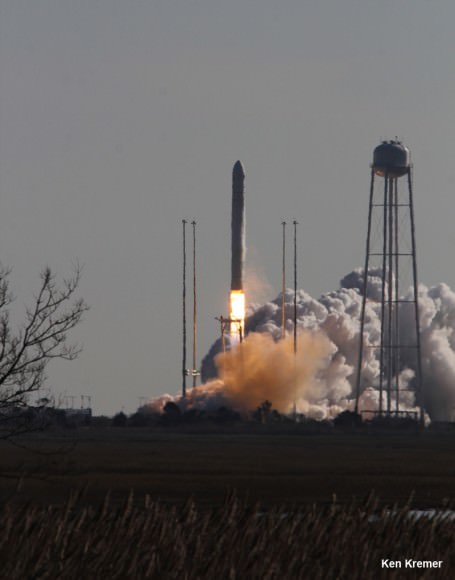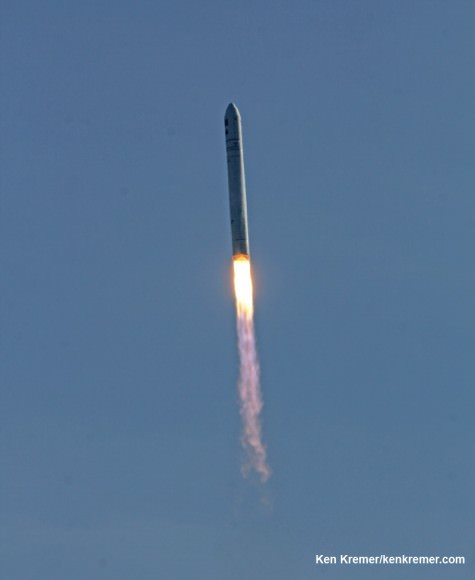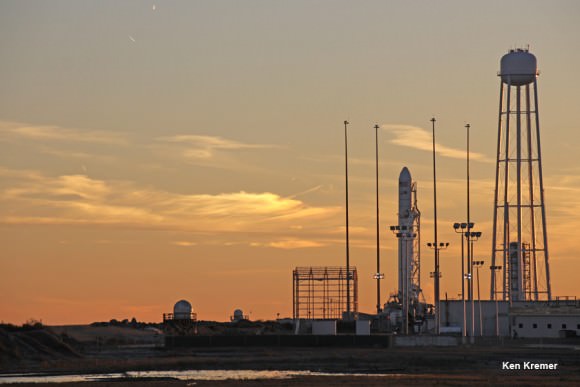Birds take flight as Antares lifts off for Space Station from Virginia Blastoff of Antares commercial rocket built by Orbital Sciences on Jan. 9, 2014 from Launch Pad 0A at NASA Wallops Flight Facility, VA on a mission for NASA bound for the International Space Station and loaded with science experiments.
Credit: Ken Kremer – kenkremer
Story updated[/caption]
WALLOPS ISLAND, VA – A private Antares rocket thundered off a Virginia launch pad today (Jan. 9) bound for the International Space Station on a breakthrough mission that marks the second successful commercial rocket launch by an American aerospace company this week – a feat that’s sure to send shock waves reverberating around the globe as well as providing an absolutely crucial life line to the station.
The majestic blastoff of Orbital Science’s Antares rocket took place from a beach side pad at NASA’s Wallop’s Flight Facility along the eastern shore of Virginia, Thursday, at 1:07 p.m. EST.
A flock of birds flew by just as Antares soared off the pad – see my lucky shot above.
The milestone flight was conducted under Orbital’s $1.9 Billion contract to NASA as the firm’s first operational cargo delivery flight to the ISS using their own developed Cygnus resupply vehicle.
“Today’s launch gives the cargo capability to keep the station going,” said Frank Culbertson, executive vice president and general manager of Orbital’s advanced spaceflight programs group, and former Space Shuttle commander.
“Everything was right on the money.”
And with the ISS lifetime in Earth orbit now newly extended by the Obama Administration to 2024, the resupply freighters pioneered by Orbital Sciences and SpaceX – in partnership with NASA – are even more important than ever before to keep the station well stocked and humming with an ever increasing array of research projects.

The goal was to restore America’s cargo and crew capabilities to low Earth orbit and the ISS that was totally lost following the forced retirement of NASA’s Space Shuttles.
Cygnus is packed chock full with a myriad of science experiments for dozens of new NASA science investigations as well as two dozen student science experiments from school across the country.

Both the terrestrial and space weather forecasts improved dramatically in the final hours of the countdown and cooperated to allow today’s magnificent Antares launch.
The launch of the two stage, 133 foot tall Antares put on a spectacular sky show that may – because of crystal clear skies – have been visible to millions of spectators spread across the US east coast from the Carolina’s to Connecticut.
Antares beautiful liftoff on Thursday comes on the heels of Monday’s (Jan. 6) SpaceX Falcon 9 liftoff .
Furthermore, it marks a grand success for the innovative US strategy of forging low cost, reliable and effective access to space by handing the task of building the rockets and cargo vehicles to US commercial companies for routine jobs in Earth orbit while NASA focuses on investing in deep space exploration.
“Today’s launch demonstrates how our strategic investments in the American commercial spaceflight industry are helping create new jobs here at home and keep the United States the world leader in space exploration,” NASA Administrator Charles Bolden said in a NASA statement.
“American astronauts have been living and working continuously in space for the past 13 years on board the International Space Station, and we’re once again sending them supplies launched from U.S. soil.”
“In addition to the supplies, the passion and hard work of many researchers and students are being carried by Cygnus today. I congratulate Orbital and the NASA teams that made this resupply mission possible.”

The fourth launch attempt was finally the charm after a trio of postponements since mid- December 2013 to fix the malfunctioning cooling system on the station, unprecedented frigid weather and then an unexpected blast of solar radiation from the Sun on Tuesday (Jan. 7) that could have fried the delicate electronics controlling the rockets ascent with disastrous consequences.

Both the Antares and Cygnus are private vehicles built by Orbital Sciences under a $1.9 Billion supply contract with NASA to deliver 20,000 kilograms of research experiments, crew provisions, spare parts and hardware to the ISS.
Orbital Sciences commercial competitor, SpaceX, is likewise under contract with NASA to deliver 20,000 kg of supplies to the ISS with the SpaceX Falcon 9/Dragon architecture.

Both the Orbital Sciences Antares/Cygnus and SpaceX Falcon 9/Dragon vehicles were developed from the start with seed money from NASA in a public-private partnership.
The flight is designated the Orbital-1, or Orb-1 mission.
A total of eight Antares/Cygnus missions to the space station are scheduled over the next two to three years by Orbital under its Commercial Resupply Services (CRS) contract with NASA.
Two additional Antares/Cygnus flight are slated for this year.
They are slated to lift off around May 1 and early October, said Culbertson.
This launch follows a pair of successful launches in 2013, including the initial test launch in April and the 1st demonstration launch to the ISS in September.
Cygnus is loaded with approximately 2,780 pounds / 1,261 kilograms of cargo for the ISS crew for NASA including science experiments, computer supplies, spacewalk tools, food, water, clothing and experimental hardware.
33 cubesats are also on board that will be deployed over time by the 6 person crew living aboard the ISS.
Among the research items packed aboard the Antares/Cygnus flight are an experiment to study the effectiveness of antibiotics in space and a batch of 23 student experiments involving life sciences topics ranging from amoeba reproduction to calcium in the bones to salamanders.
The student experiments selected are from middle school and high school teams from Michigan, Texas, Colorado, and Washington, DC.

Science experiments from these students representing six schools across America were selected to fly aboard the Cygnus spacecraft which launched to the ISS from NASA Wallops, VA, on Jan . 9, 2014, as part of the Student Spaceflight Experiments Program (SSEP). Credit: Ken Kremer – kenkremer.com
There is also an ant farm aboard with ant colonies from Colorado, North Carolina and of course host state Virginia too. The goal is to study ant behavior in space in zero gravity and compare that to ants on Earth living under normal gravity.
Cygnus will rendezvous with the station on Sunday, Jan 12.
Expedition 38 crew members aboard the station will grapple Cygnus with the stations robotic arm Sunday at 6:02 a.m. EDT.
NASA TV will provide live coverage of Sunday’s docking.

Watch for my ongoing Antares launch reports from on site at NASA Wallops.
Stay tuned here for Ken’s continuing Orbital Sciences, SpaceX, commercial space, Chang’e-3, LADEE, Mars and more news.



Launch video, by NASA :
Thanks for posting the NASA video. It would be nice if Universe Today would link to appropriate additional content such as this in their stories, but it seems their embedded links are always to other stories on Universe Today.
They did, just not in this article but one after it, which i admit, might be a bit tricky to find a couple of days later.
Here are more launch photos and the above video, collected by Ken Kramer :
http://www.universetoday.com/107988/cygnus-commercial-carrier-hurtling-towards-space-station-rendezvous-following-spectacular-antares-blastoff-photo-video-gallery/
I wonder why we need two east-coast launch facilities? Plenty of room at the Cape. I get that the Air Force can be a pain, but still. Why two?
If one blows up, you still have the spare launch facility.